Moana Hotel
The Moana Hotel is a historic hotel building in Honolulu, Hawaii, located at 2365 Kalākaua Avenue in the Waikiki neighborhood. Built in the late 19th century as the first hotel in Waikiki, the Moana opened in 1901. It is listed on the National Register of Historic Places. The hotel was also inducted into Historic Hotels of America, the official program of the National Trust for Historic Preservation, in 1989.[2] The building is currently part of the resort complex known as Moana Surfrider, A Westin Resort & Spa and is managed by Westin Hotels & Resorts.
Moana Hotel | |
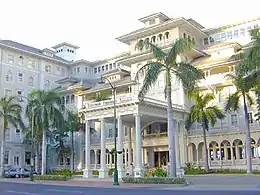 Moana Hotel entrance | |
| Location | Honolulu |
|---|---|
| Coordinates | 21°16′35.4″N 157°49′35.9″W |
| Built | 1901 |
| Architect | Oliver G. Traphagen |
| Architectural style | Hawaiian Gothic |
| Website | www |
| NRHP reference No. | 72000417[1] |
| Added to NRHP | August 7, 1972 |
History
Moana Hotel
The wealthy Honolulu landowner Walter Chamberlain Peacock, in an effort to establish a fine resort in the previously neglected Waikiki area of Honolulu, incorporated the Moana Hotel Company in 1896. Working with a design by architect Oliver G. Traphagen and $150,000 in capital, The Lucas Brothers contractors completed the structure in 1901. Construction of The Moana marked the beginning of tourism in Waikiki, becoming the first hotel amidst the bungalows and beach houses. In Hawaiian, moana means open sea or ocean.
The Moana's architecture was influenced by European styles popular at the time, with Ionic columns and intricate woodwork and plaster detailing throughout the building. The Moana was designed with a grand porte cochere on the street side and wide lānais on the ocean side. Some of the 75 guest rooms had telephones and bathrooms (unusual at the time), and the hotel featured a billiard room, saloon, main parlor, reception area, and library. Peacock installed the first electric-powered elevator in the islands at the Moana, which is still in use.[3] Design features of the original structure that survive to this day include extra-wide hallways (to accommodate steamer trunks), high ceilings, and cross-ventilation windows (to cool the rooms prior to air conditioning).
The Moana officially opened on March 11, 1901. Its first guests were a group of Shriners, who paid $1.50 per night for their rooms. Peacock did not find success with his endeavor and sold the hotel on May 2, 1905[4] to Alexander Young, a prominent Honolulu businessman who also owned the adjacent Honolulu Seaside Hotel and the Alexander Young Hotel in downtown Honolulu.[5] After Young died in 1910, his Territorial Hotel Company operated the hotel.
The Moana grew along with the popularity of Hawaiian tourism. Two floors were added in 1918, along with Italian Renaissance-styled concrete wings on each side of the hotel, creating its H-shape seen today.[6] In 1925, the hotel opened a series of wood frame bungalows on a large plot of land directly across Kalakaua Avenue, where the ʻĀinahau estate of Princess Kaʻiulani had been located.
The Matson Navigation Company and Castle & Cooke bought a controlling interest in the Territorial Hotel Company in 1925, in order to demolish their Honolulu Seaside Hotel and construct the Royal Hawaiian Hotel on the site.[7] Tourism to Hawaii collapsed due to the Great Depression and the Territorial Hotel Company declared bankruptcy in September 1933, with Matson assuming control of their hotels through its Hawaii Properties Ltd. division, and Castle & Cooke writing off their investment.[8]
Throughout the 1930s, the hotel was known as the Moana-Seaside Hotel & Bungalows, taking on the name of its demolished neighbor.[6]
In 1941, Hawaii Properties Ltd. was dissolved and Matson assumed direct control of the hotel.[9]
The hotel's outward appearance was altered slightly over the years, including "updates" to such designs as Art Deco in the 1930s and Bauhaus in the 1950s.
From 1935 to 1975, the Moana's courtyard hosted the Hawaii Calls live radio broadcast. Legend has it that listeners mistook the hiss of the radio transmission as the waves breaking on the beach. Upon learning of this, the host instructed the sound man to run down to the waterfront to actually record the sound, which became a staple of the show.
In 1952, Matson built a new hotel adjacent to the Moana on the southeast side, called the SurfRider Hotel. In 1953, Matson demolished the Moana's bungalows across the street and, two years later, opened the new Princess Kaiulani Hotel on the site.[10] Matson sold all of their Waikiki hotel properties to the Sheraton Hotels and Resorts in 1959.[11]
Sheraton sold the Moana and the SurfRider to Japanese industrialist Kenji Osano and his Kyo-Ya Company in December 1963 for $10.7 million,[12] though Sheraton continued to manage them. In 1969, Kyo-Ya built a towering new hotel on the Moana's northwest side. They named it the Surfrider Hotel. The older SurfRider Hotel on the other side was turned into part of the Moana, named the Diamond Head Wing.
Moana Surfrider
In 1989, a $50 million restoration (designed by Hawaii architect Virginia D. Murison) restored the Moana to its 1901 appearance and incorporated the 1969 Sheraton Surfrider Hotel and the 1952 SurfRider Hotel buildings with the 1901 Moana Hotel building into one beachfront resort, the Sheraton Moana Surfrider. The new resort included 793 rooms (including 46 suites), a freshwater swimming pool, three restaurants, a beach bar and a poolside snack bar. The property has been recognized with the President's Historic Preservation Award, the National Preservation Honor Award, the Hawaii Renaissance Award, and the Hotel Sales and Marketing Association International Golden Bell Award. The main historic section of the hotel, the Banyan Wing, has been listed on the National Register of Historic Places.
The hotel was the base of operations for about 24 White House staffers who accompanied President Barack Obama to his Winter White House at Plantation Estate during Christmas visits.[13]
In 2007, Starwood Hotels & Resorts, the management company of the Moana, rebranded the hotel from Sheraton Hotels and Resorts to Westin Hotels & Resorts. The name of the hotel became Moana Surfrider, A Westin Resort & Spa. The 1901 wing is now known as the Historic Banyan Wing. The low-rise 1952 SurfRider Hotel building is today the Diamond Wing. The 1969 Surfrider Hotel building is now called the Tower Wing.[14]
The banyan tree
In the center of the Moana Surfrider's courtyard stands a large banyan tree. The Indian banyan tree was planted in 1904 by Jared Smith, Director of the Department of Agriculture Experiment Station. When planted, the tree was nearly seven feet tall and about seven years old. It now stands 75 feet (23 m) high and spans 150 feet (46 m) across the courtyard.
In 1979, the historic tree was one of the first to be listed on Hawaii's Rare and Exceptional Tree List. It has also been selected by the Board of Trustees of the America the Beautiful Fund as the site for a Hawaii Millennium Landmark Tree designation, which selects one historic tree in each state for protection in the new millennium.
Hotel lore
Rich and famous
As soon as the Moana Hotel opened, a non-stop flood of tourists from the mainland United States poured through its doors. Its most famous guest came in 1920. The Prince of Wales, who would later become King Edward VIII, gallivanted around the Moana Hotel property and reportedly fell in love with the private pier, from which he frequently dove into the ocean.
In August 1922, author Agatha Christie and her husband, Colonel Archie Christie, stayed on holiday. They were traveling around the world as part of the Dominion Mission of the British Empire Exhibition, promoting the exhibition to be held in England in 1924.[15]
In February 1905, Jane Stanford, co-founder of Stanford University, died of strychnine poisoning in a room at the Moana Hotel. Stanford is believed to have been murdered, but the source of the strychnine was never identified.[16][17]
Gallery
 Original 1901 wing
Original 1901 wing Moana, with 1969 Surfrider tower behind it
Moana, with 1969 Surfrider tower behind it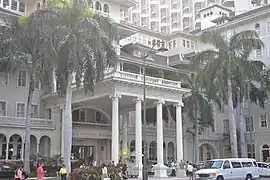 The porte cochere, recreated in the 1989 restoration.
The porte cochere, recreated in the 1989 restoration.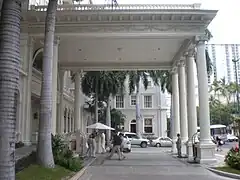 Porte cochere
Porte cochere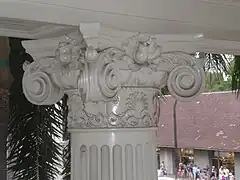 Capital of Corinthian column
Capital of Corinthian column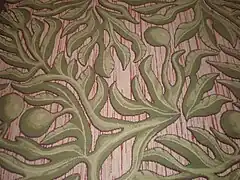 Carpet with breadfruit patterns
Carpet with breadfruit patterns Hawaiian canoe paddles on wall
Hawaiian canoe paddles on wall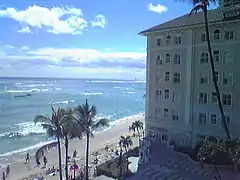 View from oceanfront guestroom
View from oceanfront guestroom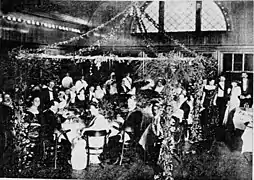 Banquet at the hotel, 1905
Banquet at the hotel, 1905
References
- "National Register Information System". National Register of Historic Places. National Park Service. January 23, 2007.
- "Hotel History - Moana Surfrider, A Westin Resort & Spa". Historic Hotels of America. Retrieved 2022-12-14.
- "Moana Hotel". National Park Service.
- "The Hawaiian Gazette from Honolulu, Hawaii on May 2, 1905 · Page 7".
- Hibbard, Don (2006). Designing Paradise: The Allure of the Hawaiian Resort. Princeton Architectural Press. p. 34. ISBN 9781568985749 – via Google Books.
- Philpotts, Kaul (April 11, 2001). "100 years of Moana dining". Honolulu Advertiser.
- Hibbard, Don (January 1, 2006). Designing Paradise: The Allure of the Hawaiian Resort. Princeton Architectural Press – via Google Books.
- Hitch, Thomas Kemper (November 1, 1992). Islands in Transition: The Past, Present, and Future of Haiwaii's Economy. First Hawaiian Foundation – via Google Books.
- Alexander, Geoff (December 21, 2018). America Goes Hawaiian: The Influence of Pacific Island Culture on the Mainland. McFarland – via Google Books.
- "History of the Princess". princess-kaiulani.com. Kyo-ya Company, Starwood Hotels. Archived from the original on March 5, 2016.
- "History". matson.com. Matson.
- "Timeline". kyoyahotelsandresorts.com. Kyo-ya Hotels. Archived from the original on April 20, 2014.
- Zimmerman, Malia. "Obama's Million Dollar Hawaiian Vacation: Costs to Taxpayers Detailed". Hawaii Reporter. Archived from the original on April 10, 2011.
- "Rooms & Suites". moana-surfrider.com. Archived from the original on September 5, 2015.
- Prichard, Agatha Christie (2012). The grand tour : letters and photographs from the British Empire Expedition 1922. London: HarperCollins. pp. 263–305. ISBN 9780007447688.
- Wolfe, Susan (September–October 2003). "Who Killed Jane Stanford?". Stanford Magazine.
- Dowd, Katie (2018-01-08). "In 1905, someone murdered the founder of Stanford University. They've never been caught". SFGATE. Archived from the original on January 3, 2019.
Further reading
- Stan Cohen. 1996. A Pictorial History of the Sheraton Moana Surfrider, Pictorial Histories Publishing Company, Inc.
- Robert W. P. Cutler. 2003. The Mysterious Death of Jane Stanford, Stanford University Press.
- Glen Grant. 1996. Waikīkī Yesteryear, Mutual Publishing Co.
- Don Hibbard and David Franzen. 1995. The View from Diamond Head: Royal Residence to Urban Resort, Editions Ltd.
- George S. Kanahele. 1996. Waikīkī, 100 BC to 1900 AD: An Untold Story, University of Hawaiʻi Press.
- Pukui, Mary K., Samuel H. Elbert, and Esther T. Mookini. 1976. Place Names of Hawaiʻi, Revised & expanded edition. Univ. Press of Hawaiʻi, Honolulu. 289 pp.
- Schaefers, Allison (January 25, 2007). "Starwood redo to give Moana new branding". Honolulu Star-Bulletin.